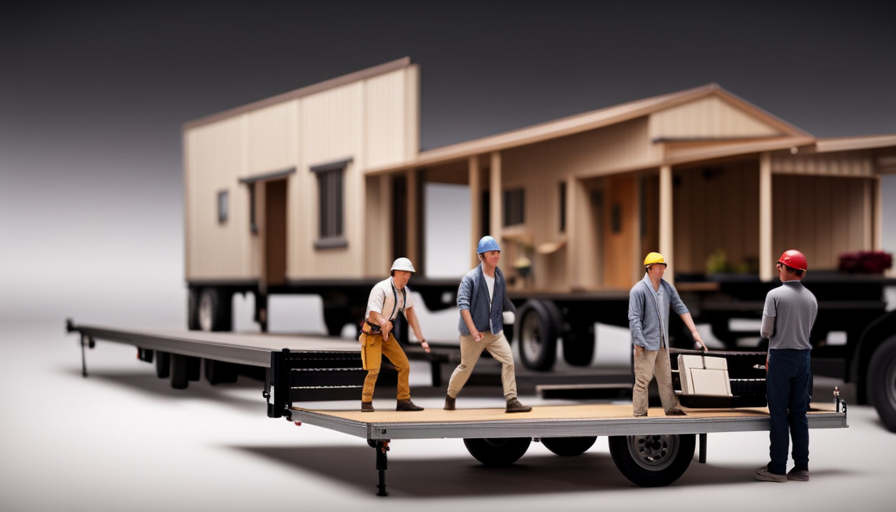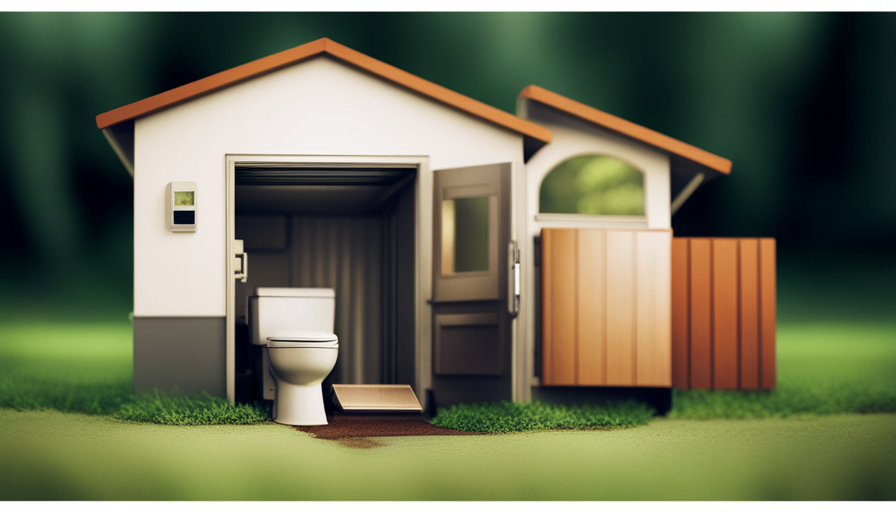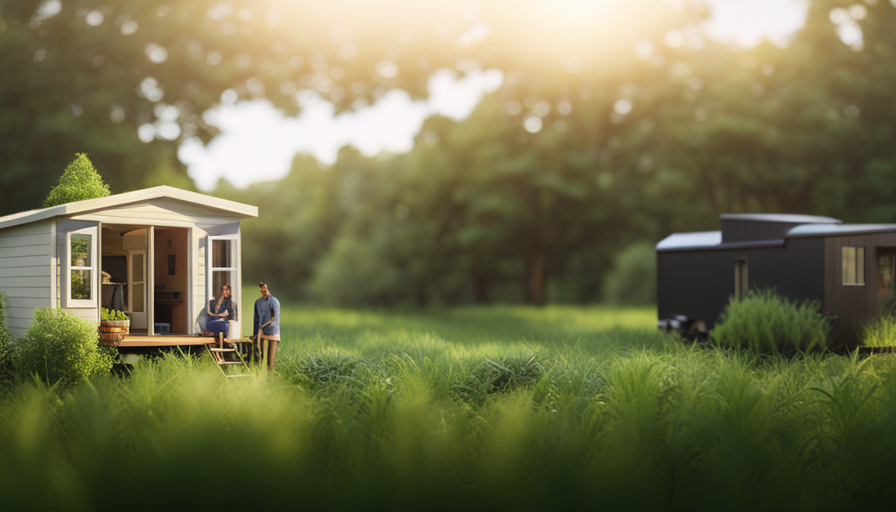Have you ever considered the process of moving a small house?
Well, here’s the truth: moving a tiny house may seem like a daunting task, but with proper planning and preparation, it can be a smooth and exciting adventure.
Whether you’re relocating to a new city or simply want a change of scenery, moving your tiny house requires careful consideration of its size, weight, and route.
In this article, we will guide you through the process of moving a tiny house, from planning your route and obtaining permits to hiring professional movers or doing it yourself.
We’ll also provide tips on how to use the right equipment, secure your tiny house, disconnect utilities, inform your neighbors, and set up your tiny house in its new location.
So, if you’re ready to embark on a new tiny house adventure, let’s get started!
Key Takeaways
- Careful planning and preparation are necessary when moving a tiny house.
- Consider the size and weight of the tiny house before choosing a transportation method.
- Obtain necessary permits and plan the route carefully, considering well-maintained routes with minimal traffic.
- Hiring professional movers and using proper equipment can ensure expertise, efficiency, and safety during the move.
Consider the Size and Weight of Your Tiny House
Before you start moving your tiny house, it’s crucial to take into account the size and weight of it. These considerations will determine the transportation methods you can use and ensure a safe and successful move.
First, measure the dimensions of your tiny house, including height, width, and length. This will help you determine if the house can fit under bridges, through tunnels, or on narrow roads.
Next, calculate the total weight of your tiny house, including all the furniture and belongings inside. This information is important because it will dictate the type of vehicle you’ll need to transport it.
Once you have these measurements, you can explore different transportation methods. One option is to hire a professional moving company that specializes in tiny house relocation. They have the expertise and equipment to safely transport your tiny house to its new location.
Another option is to tow your tiny house using a suitable vehicle, such as a truck or SUV. However, keep in mind that you’ll need to have experience and knowledge in towing heavy loads.
Considering the size and weight of your tiny house is crucial to plan its transportation. By taking these factors into account, you can determine the best method for moving your tiny house safely and efficiently.
Now that you have considered the size and weight of your tiny house, the next step is to plan your route and obtain necessary permits for the move.
Plan Your Route and Obtain Necessary Permits
To successfully transport a compact dwelling, it’s crucial to map out your desired path and secure the required licenses. Planning your route is essential to avoid any unexpected obstacles or restrictions along the way.
Take into consideration the width and height of your tiny house, as well as any low bridges or narrow roads that may pose a challenge. It’s advisable to choose routes that are well-maintained and have minimal traffic to ensure a smoother journey.
Obtaining necessary permits is another crucial step in moving your tiny house. Depending on your location, you may need to apply for oversize load permits, which allow you to transport a structure that exceeds the standard size limits. These permits are typically issued by state or local transportation departments and may require documentation such as proof of insurance and detailed plans of your route.
Once you have planned your route and obtained the necessary permits, you can proceed to the next step: preparing your tiny house for transportation. This involves securing loose items, disconnecting utilities, and ensuring that the structure is properly secured to the trailer or vehicle that will be used for transport.
Prepare Your Tiny House for Transportation
Once everything is in place, make sure your compact dwelling is securely fastened to the trailer or vehicle, ensuring a smooth and stable journey.
To prepare your tiny house for transportation, there are a few important steps to follow.
First, you need to prepare the utilities. Start by disconnecting the power supply and securing any loose wires. Turn off the water supply and drain all the pipes to avoid leaks during the move. If you have propane tanks, make sure they’re turned off and securely fastened.
Next, secure your furniture to prevent any damage or shifting during transportation. Use strong straps or bungee cords to hold down larger items, such as sofas or tables. For smaller items, consider using bubble wrap or padding to protect them from bumps and vibrations.
In addition, make sure all windows, doors, and cabinets are securely closed and locked. This’ll prevent any unwanted movement or damage to the interior of your tiny house.
Double-check everything to ensure that nothing’s loose or likely to shift during transit. Once you’ve completed these preparations, you’ll be ready to move your tiny house.
To transition into the subsequent section about hiring a professional moving company or DIY, it’s important to consider your own capabilities and resources.
Hire a Professional Moving Company or DIY
If you’re looking for a stress-free and efficient way to transport your compact dwelling, consider hiring a professional moving company. Professional movers have the expertise and experience to handle the logistics of moving a tiny house safely and securely. They have the necessary equipment and knowledge to ensure that your tiny house is properly loaded, transported, and unloaded at its destination.
To help you understand the benefits of hiring professional movers versus doing it yourself, here is a cost comparison table:
| Professional Movers | DIY | |
|---|---|---|
| Cost | $$ | $ |
| Expertise | High | Low |
| Efficiency | High | Low |
| Time Required | Less | More |
| Stress Level | Low | High |
As you can see, while hiring professional movers may involve a higher cost, it offers numerous advantages. It saves you time, reduces stress, and ensures that your tiny house is moved safely and efficiently. Transitioning into the subsequent section about ‘use proper equipment and secure your tiny house,’ it’s important to consider these factors when preparing to move your compact dwelling.
Use Proper Equipment and Secure Your Tiny House
Ensure that your compact dwelling remains safe and secure during the move by using the proper equipment and taking necessary precautions.
When it comes to moving a tiny house, having the right equipment is crucial. One of the most important tools you’ll need is a heavy-duty trailer specifically designed for transporting tiny houses. Make sure the trailer’s in good condition and can support the weight of your tiny house.
Invest in sturdy straps and tie-downs to secure your tiny house to the trailer. These’ll help prevent shifting or movement during transit.
When it comes to securing your tiny house, there are a few techniques you can employ. Begin by inspecting all doors, windows, and external attachments to ensure they’re properly closed and secured. For added protection, consider installing temporary braces or supports to reinforce the structure. This’ll help minimize any potential damage during the move. Additionally, use foam or rubber padding to protect delicate components and fragile items inside your tiny house.
By utilizing the proper equipment and securing techniques, you can significantly reduce the risk of damage to your tiny house during the move. However, it’s important to remember that safety should always be your top priority.
In the next section, we’ll discuss the importance of following safety guidelines and regulations to ensure a smooth and successful move.
Follow Safety Guidelines and Regulations
Following safety guidelines and regulations is crucial when transporting a compact dwelling, as it ensures a smooth and successful move while reducing the risk of accidents and damage. According to a study conducted by the Federal Motor Carrier Safety Administration, adhering to these guidelines can significantly decrease the likelihood of incidents during the transportation of mobile homes.
To ensure safety, there are several precautions that should be taken. Firstly, it’s essential to secure all loose items inside the tiny house to prevent shifting during transport. This can be done by using straps or bungee cords to secure furniture and other belongings. Additionally, it’s important to check the weight capacity of the towing vehicle and adhere to it strictly. Overloading the vehicle can lead to instability and accidents.
Moreover, it’s crucial to comply with all legal requirements and obtain the necessary permits for transporting the tiny house. Each state may have its specific regulations regarding the transportation of oversized loads, so it’s essential to research and follow these regulations accordingly.
By following safety precautions and legal requirements, you can ensure a safe and hassle-free move for your tiny house.
Now that you understand the importance of safety guidelines and regulations, the next step is to communicate with utility companies and disconnect services.
Communicate with Utility Companies and Disconnect Services
To effectively transition your compact dwelling, it’s crucial that you promptly communicate with utility companies and arrange for the disconnection of services.
Before you move your tiny house, it’s important to contact your utility providers, such as electricity, water, and gas, to inform them about your upcoming relocation. This will allow them to schedule the disconnection of services on the specified moving day, ensuring a smooth transition. Make sure to provide them with the new address where you’ll need the services to be reconnected.
In addition to notifying utility companies, it’s also important to communicate with your neighbors about your move. Inform them about the upcoming relocation and any potential disruptions it may cause, such as noise or temporary parking restrictions. This will help maintain good relations with your neighbors and minimize any inconvenience caused.
During the period when your tiny house is being moved, you’ll need to find temporary housing. This can be a hotel, a friend’s place, or even renting another small space until your tiny house is safely relocated. Make sure to plan ahead and secure temporary accommodation to ensure a smooth transition.
By communicating with utility companies and neighbors and finding temporary housing, you’re taking the necessary steps to prepare for your move. In the next section, we’ll discuss how to inform your neighbors and prepare for the move without causing any disruptions.
Inform Your Neighbors and Prepare for the Move
Before you start the process of informing your neighbors and preparing for the move, it’s important to remember that good communication can go a long way in making the transition smooth and hassle-free. When it comes to informing your neighbors, it’s considerate to let them know well in advance about your plans to move your tiny house. This will give them time to adjust and make any necessary arrangements on their end.
You can either have a face-to-face conversation or leave a friendly note explaining the situation.
Once you have informed your neighbors, the next step is to find reliable movers who specialize in moving tiny houses. Look for professionals who have experience in handling small and delicate structures like yours. Ask for recommendations from friends, family, or even online communities dedicated to tiny house living. It’s important to choose a company that’s insured and provides a written contract to protect both parties involved.
To better prepare for the move, create a checklist of all the items that need to be done before, during, and after the move. This will help you stay organized and ensure that you don’t miss any important steps. Some things to consider include securing loose items inside your tiny house, disconnecting utilities, and ensuring that your belongings are properly packed and protected.
With your neighbors informed and reliable movers hired, it’s time to set up your tiny house in the new location. [Transition sentence into subsequent section about ‘set up your tiny house in the new location’]
Set Up Your Tiny House in the New Location
Now that you’ve successfully moved your tiny house to its new location, it’s time to set it up and make it feel like home.
The set-up process involves carefully arranging the interior of your tiny house to optimize space and create a comfortable living environment.
Start by unpacking your belongings and organizing them in a way that maximizes storage and accessibility. Since space is limited in a tiny house, consider using multi-functional furniture and storage solutions to make the most of every inch. Install shelves, hooks, and bins to keep items organized and out of the way.
Next, focus on the interior design of your tiny house. Choose a color scheme that reflects your personal style and makes the space feel inviting. Use curtains, rugs, and artwork to add character and warmth to your tiny home. Consider incorporating space-saving techniques, such as using foldable furniture or hanging plants to add greenery without taking up valuable floor space.
As you complete the set-up process, take a moment to admire your new tiny house adventure. The hard work of moving and setting up your tiny house has paid off, and now it’s time to enjoy the fruits of your labor. Get ready for a life of simplicity, freedom, and endless possibilities in your new tiny house!
Enjoy Your New Tiny House Adventure!
Embracing the simplicity and freedom of your new tiny house adventure, you can now fully immerse yourself in the endless possibilities that await. As you settle into your new tiny home, you’ll quickly discover the unique charm and benefits of the new tiny house lifestyle.
Living in a tiny house presents its own set of challenges, but with careful planning and a positive mindset, you can overcome them and create a fulfilling life in your compact space. One of the most significant challenges of living in a tiny house is the limited space. However, this limitation can also be seen as an opportunity to declutter and prioritize what truly matters to you. By adopting a minimalist lifestyle, you can free yourself from the excesses of consumerism and focus on experiences and relationships instead.
You’ll learn to make the most of every square inch and find creative storage solutions that maximize your space. Living in a tiny house also requires a certain level of adaptability and resourcefulness. You’ll need to learn how to conserve energy, manage your water usage, and find innovative ways to make your tiny house feel spacious and functional. But don’t let these challenges discourage you. With time, you’ll become an expert at living efficiently and sustainably, and you’ll appreciate the sense of freedom and simplicity that comes with it.
In your new tiny house adventure, you’ll have the opportunity to connect with nature and explore the world around you. With the flexibility to move your tiny house, you can experience different landscapes, climates, and communities. Whether you decide to park your tiny house in a serene forest or a bustling urban neighborhood, you’ll have the chance to immerse yourself in new cultures, meet like-minded individuals, and create lasting memories.
As you embark on your new tiny house lifestyle, remember to stay open-minded and adaptable. Embrace the challenges as opportunities for growth and creativity. With the right mindset and a willingness to explore, your tiny house adventure will be filled with joy, simplicity, and a newfound appreciation for the things that truly matter in life.
Frequently Asked Questions
How much does it cost to move a tiny house?
Moving a tiny house can cost anywhere from $1,000 to $10,000, depending on various factors. Cost considerations include the distance of the move, transportation fees, and permits. However, it’s important to be aware of hidden expenses such as crane or forklift rentals, professional help, and utility disconnection and reconnection fees.
To get an accurate estimate, it’s recommended to consult with professional movers and obtain multiple quotes. Proper planning and budgeting are key to avoiding surprises.
Can I move my tiny house without obtaining permits?
Moving a tiny house without obtaining permits is like trying to drive without a license – it’s risky and could get you in trouble. To ensure a smooth and legal move, it’s important to research the specific legal requirements in your area.
These may include obtaining permits, notifying local authorities, and following certain regulations. By taking the necessary steps and adhering to the legal requirements, you can safely and legally move your tiny house to its new location.
What kind of equipment do I need to secure my tiny house during transportation?
To secure your tiny house during transportation, you’ll need a few key pieces of equipment.
First, make sure you have sturdy tie-down straps or chains to anchor your house to the trailer.
Use ratchet straps to tightly secure any loose items inside the house.
Additionally, consider installing wheel chocks to prevent your tiny house from rolling during transit.
Finally, don’t forget to inspect and reinforce any weak spots on your house’s structure to ensure it can withstand the journey.
Are there any height or width restrictions for moving a tiny house?
Navigating the road with a tiny house is like dancing on a tightrope. When it comes to height restrictions, make sure your tiny house isn’t higher than 13.5 feet, or you might meet an unwelcome bridge. Keep the width under 8.5 feet to avoid unwanted encounters with roadside obstacles. Remember, following these limitations will ensure a smooth and hassle-free journey for your cozy abode.
How long does it typically take to move a tiny house?
To prepare your tiny house for transportation, you should start by securing all loose items and removing any fragile belongings. Disconnect utilities, secure doors and windows, and check the structural integrity of the house.
When hiring a professional tiny house mover, ensure they have experience with tiny houses and proper equipment. Get multiple quotes and ask for references.
The time it takes to move a tiny house varies depending on distance, road conditions, and any necessary permits, but it typically ranges from a few hours to a few days.
Conclusion
Congratulations on successfully moving your tiny house! You’ve navigated the challenges and intricacies involved in relocating your little abode with finesse.
Just like a captain steering a ship, you’ve charted your course and sailed through the process with confidence.
Remember, moving a tiny house is not just about physically transporting it; it’s about embarking on a new adventure, a journey towards a simpler and more sustainable way of living.
So, as you settle into your new location, embrace the possibilities and savor every moment of your tiny house adventure!
Hi, I’m Emma. I’m the Editor in Chief of Tiny House 43, a blog all about tiny houses. While tree houses are often associated with childhood, they can be the perfect adult retreat. They offer a cozy space to relax and unwind, surrounded by nature. And since they’re typically built on stilts or raised platforms, they offer stunning views that traditional homes simply can’t match. If you’re looking for a unique and romantic getaway, a tree house tiny house might just be the perfect option.










